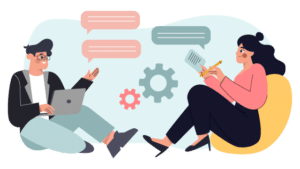Instructional design was once how we created learning materials when learning could still be a bit boring and difficult. It was content-based and a way to match content to the right delivery methods. Great for bare-bones training, but not as effective for that deep-down, impactful learning employees crave. That’s why we utilize learning experience design as a method for putting the individual learner at the heart of every program we create.
Learning experience design is unlimited: a blank canvas on which anything can be painted. The objective is to create learning experiences and tap into individual learning styles that truly captivate the user and make the enterprise delightful, emotional, and even surprising, all with the goal that they have an impactful experience that actually changes the way they think, feel, and act.
According to a study, when students are engaged, motivated, and feel less stressed, information flows freely through the affective filter in the amygdala, and they achieve higher levels of cognition, make more connections, and experience “aha” moments. Surprisingly, this does not come from quiet classrooms; it comes from classrooms with an atmosphere of exuberant discovery. When the content is relevant to their lives and experiences, and the atmosphere is energetic, people find learning easier. Stress, boredom, and anxiety are cognitive inhibitors. This brings us to the question: What is a learner-centered approach and why is it a superior method for teaching complex topics?
What is a learner centered approach?
A learner-centered approach views design through the lens of user experience rather than the content itself. Personalized learning is the foundation for a learner-centered approach. It puts the learner’s unique experience foremost in the design of the learning materials. It’s a learner-centric approach that creates a relevant, engaging, and personalized experience out of learning content.
Related: Employee engagement training
Curious about how a learner-centered approach can benefit your team? Contact us today to see our innovative solutions in action.

Understanding learner-centered approach design theory
The beginnings of understanding the learner-centered approach theory were written by Soloway, Guzdian, and Hay in 1994. Their theory has since been built on and adapted. In 1996, Zharias and Poulymenakou developed a comprehensive prototype to be used for eLearning. The design had five key focus points:
- Allowing learners to discover things for themselves
- Having clearly defined learning objectives
- Using informative feedback
- Designing to gain the learners’ attention
- Employing visual elements to enhance meaning and facilitating social learning
Our current adult learning theory creates a motivational learning experience suited to each individual. Fundamental to learner-centered approach theory is the concept of scaffolds. These scaffolds are worked into the software to support the learner. Examples are hints, explanations, and encouragement to help learners gain a better understanding. Additionally, scaffolds are built in as questions that help learners process and throw back information.
Focus on the individual learning process
A learner-centered approach focuses on the individual who will be learning; the content and interface are created around what they will think and feel when learning. Therefore, to respect and honor that personal learning process, we don’t create the materials and simply deliver them to the learner—we put the learner first and create the materials around their experience. Everyone has a personal process and, with clever design and plenty of opportunities for personalization, we can deliver a unique experience to each and every learner.
When the LXD (Learning eXperience Designer) is creating the learning materials, they have to be so focused on the learner that they have to think of every eventuality for every individual. It’s like a choose-your-own-adventure for personalized learning. For example, accessibility is a requirement for many learners. This has to be thought of, and there are ways LXDs can ensure access for all—whether it means designing around e-reader compatibility or changing the contrast to remove any potential barriers to a positive experience. Designing for the learner and their unique cognitive load will ensure a successful learning experience.
Related: Tips for more accessible learning
The four principles of a learner-centered approach
There are four principles that create an effective learner-centered approach experience:
#1 Context
Learning content and tasks should be relevant to the learner and their lives. They should be able to relate to content and connect personally with what they are learning. This is where eLearning training for the workplace shines—learning about the job you are doing is highly relevant and engaging, thereby producing amazing results.
#2 Construction
Learners should be able to connect their own experiences with new content and new information should build on prior knowledge. Keeping a digital record of what has been covered is a great way to ensure time is saved and only new materials are offered to the learner.
# 3 Conversation
Social learning facilitates deeper learning. Learners should be able to discuss the subject matter with a trainer and with other learners. We think that eLearning is especially great here, as interfaces can facilitate chat rooms and forums where learners can easily and comfortably discuss anything.
#4 Collaboration
If the learner is exposed to others’ ideas, it can shape an individual’s own ideas and encourage further learning. It will help them develop, test, and analyze ideas, although they will still form their own. Working together on assignments and contributing equally towards the outcome builds collaboration skills and exposes learners to ideas they may not have considered before.
Want to know more about our learner-centered design principles? Explore our case studies to see how we’ve helped other organizations succeed.

Implementing a learner-centered design approach: Best practices
Whether you have existing learning content that could use a learner-first edit or you’re starting from scratch, you can start putting your learners at the heart of your training today. Here are some of our favorite ways to get started.
Identify your target audience
If you know that a personalized learning experience is the best way to encourage knowledge transfer, you also need to recognize the “person” behind those personalization efforts. Start your process by defining your target audience. What should they be doing? What are the existing barriers between them and that behavior? How do they spend their time, and what are some of their learning styles? As you work to identify your target audience, your learner-centered design approach will start to take shape.
Conduct a training needs analysis
Once you’ve gotten to know your target audience, your next step in the approach is to then conduct a training needs analysis. It’s a technical way to simply ask “What do learners need to know?” and “How should they act?” It’s basically a way for you to define your learning objectives in a more personalized way. Instead of generalizing how training would benefit your organization, focus on how the learning experience can benefit learners individually.
Reduce content
This one might seem like it’s counterintuitive, but we promise that less is more when it comes to a learner-centered design approach. Too often we see learning modules that overload learners with information and leave it up to the user to sort through what is and isn’t relevant. More often than not, the content will either be a) irrelevant to the learner in their roles or b) discarded in favor of more streamlined ways to learn like simply asking a colleague.
If you’re keeping learners at the center of the learning process, keep learning topics as hyper-relevant as you can. Consider not only what they need to learn but when they need to learn it: You might find you can hold back some content or allow learners more autonomy to move throughout the experience and pick and choose what they need to know right now.
Respect the cognitive load
We love things like animations, graphics, GIFs, fun text, and sound. They can all add to an engaging course. Still, your learners’ brains can only process so much information and too much of a good thing could result in cognitive load. Pare down the tools you use to convey information and allow users the chance to opt out. Remember that you don’t know every learner’s personal environment and ability. Something as simple as using captions and allowing learners to turn off sound could help reduce cognitive load and toggle an experience that’s comfortable and useful for them on an individual basis.
Give learners their power
When in doubt, give the power to your learners. You’re defining the content and creating the experiences, and you can trust your learners to take it from there. When learners can seek out their own training instead of waiting around for it to be delivered, they get their power back. When you build resources that engage and let users practice on their own terms (think quizzes and discussion boards), they get their power back. When you encourage instructors to transition into a facilitator role to design scenarios, ask thought-provoking questions, or offer as-needed guidance, you’re giving learners their power back.
Curious about how a learner-centered approach can benefit your team? Contact us today to see our innovative solutions in action.
What is the meaning of a learner-centered curriculum?
Learner-centered curriculum is when the learner participates in the decision-making of the design process and chooses parts of the learning experience for themselves. Fundamental to a learner-centered curriculum is its flexibility—people are not machines. Learning should provide the flexibility to make choices and have room to explore and discover.
The most basic principles of even the early learner-centered curriculum theories were freedom to develop naturally, interest in the work as the primary motivation, and the teacher facilitating the discovery and learning process. These early theories were a result of dissatisfaction expressed by learners. This brought the focus to the real needs and interests of the students. Who better to serve as guides?
The essence of a learner-centered design approach
Looking to the learner when we design learning materials will always result in great returns. People (and their unique experiences) are infinite sources of inspiration, and focusing on the individual experience will ensure better learning experiences for all learners and fulfillment for designers and educators. When students are enjoying the process and are successful, everyone involved thrives. Mark van Dorn said, “The art of teaching is the art of assisting discovery.” The art of teaching truly comes alive in a learner-centered approach.
The answer to the question: “What is a learner-centered approach?” has been answered theoretically, but it’s much more than just a learning theory. It encompasses the experience of learning and gaining knowledge transformed into an intensely enjoyable, exhilarating adventure. It facilitates an inspirational way to fulfill that lifelong quest. In short, learner-centered design puts the quest for knowledge back on the map.
Curious about how a learner-centered approach can benefit your team? Contact us today to see our innovative solutions in action.





